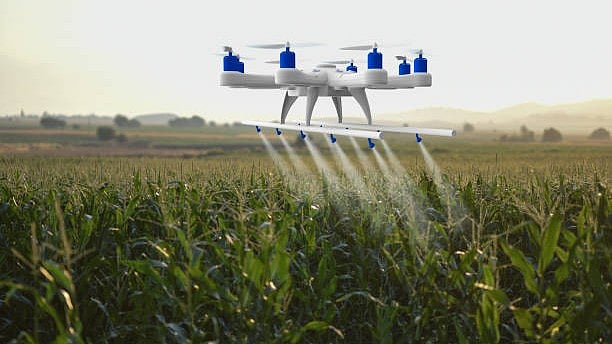
Image for representational purposes.
Credit: iStock Photo
The latest is that Bill Gates has “witnessed drone revolution in India”, and that gender stereotypes were getting broken through the Drone Didi scheme-related trainings being imparted to rural women. Fine. But what is it about technology that compels our political leaders and bureaucrats to accept several things unquestioningly, without much thought on the safety and political economy associated with specific technologies? Why is it that such technologies are thrust as “solutions” for an unspecified problem to begin with? These questions are inevitable when one looks at the promotion of drones in the country in the field of agriculture.
The government’s enthusiastic promotion of drones in agriculture, exemplified by the ‘Drone Didi’ scheme (with the promise of 15,000 women’s SHGs being equipped with drones for income generation, with subsidies for the same) has been garnering significant attention,
including from foreign media. While the narrative revolves around empowering rural women and boosting agricultural efficiency, a closer examination reveals a more complex and concerning picture.
In ASHA (Alliance for Sustainable and Holistic Agriculture, a volunteers’ platform of public-spirited citizens), we have been trying to gather the grassroots picture from states like Karnataka, Telangana, and Odisha other than monitoring media reports related to drone use in agriculture. What is becoming apparent is that there is a lack of necessary regulation and monitoring on the ground, whatever guidelines may have been prescribed on paper.
In Odisha, Drone Didis are reporting that farmers insist on mixing chemical pesticides with nano-urea. Elsewhere, in Tamil Nadu, there is this news report of Dalit farmers’ crops on panchami land getting destroyed overnight, possibly to settle some old caste feuds in the village, using a drone through which a herbicide was sprayed.
Pesticide (herbicide) drift is a matter of serious concern in the small landholdings of India. Such drift-related crop destruction and consequent conflicts are apparently the largest source of litigation between farmers in the USA. So, what do we have in store for a country of marginal landholdings like India?
The use of drones for spraying of toxic chemicals raises serious environmental and health concerns, and the adequacy of guidelines and monitoring mechanisms. This is particularly alarming given the statutory exclusion of farmers from end-use regulation under the Insecticides Act 1968.
Tech without guardrails
Incidents of drone crashes are not unheard of. There is a report of one such crash in an agricultural fair in Madhya Pradesh where a Union Minister escaped harm narrowly.
The hype surrounding drones in agriculture has led to significant investments, with some entrepreneurs spending up to Rs 25 lakh (this includes the cost of the drone, as well as the carrier vehicle, up to 10 sets of batteries, one generator for charging the batteries, spare materials and repairs, working capital costs of human resources etc). However, the economic viability of these ventures is questionable, and many are struggling to generate returns. As per one operator in Karnataka, for viable operations, one needs to take at least 40 acres’ order, to spray in one day, that too within a vicinity of 1-2 km. On the ground, maintenance issues are cropping up, mainly connected with battery-related issues.
Entrepreneurs (including drone didis) who have invested in this technology are contending with this. There are reports of enterprises closing down after 3-4 years of trying to stay afloat. So, there is a question mark on the economic viability of these hyped enterprises.
It is also seen that such drone usage is a technology fit for monocultures, and is unneeded as well as inefficient in multi-cropped farming. On the one hand, we have the Prime Minister promoting natural farming, and on the other hand, promoting schemes for drones that spray synthetic pesticides and fertilisers.
All in all, the Indian government’s push for drones in agriculture requires a closer examination. Why should there be a technology brought in to assist in the use of toxic chemicals, when the toxic chemicals need to be eliminated in the first instance? At the very least, it is a somewhat blind adoption of a technology that ignores our socio-economic realities. While the ‘Drone Didi’ scheme may have been launched with the intention of empowering rural women, the reality on the ground is marked by regulatory gaps, social and environmental concerns, economic uncertainties, and security risks. It is essential to re-evaluate the promotion of drones in agriculture and prioritise a more holistic and sustainable approach to agricultural development.
(The writer is with the Alliance for Sustainable and Holistic Agriculture)